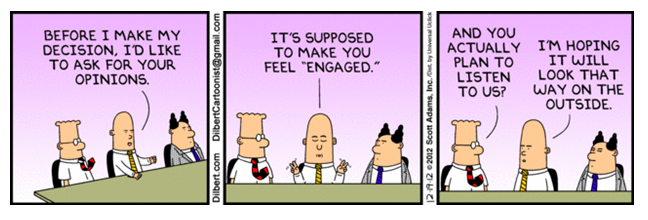Engaging leadership
What kind of leadership behaviors can promote work engagement?
Neu-Ulm University of Applied Sciences
February 14, 2024
Introduction
One of the principal responsibilities of leaders is to motivate their followers so that they will perform well. Schaufeli (2021)
Display: none
Fostering work engagement …

Group work
Discuss your answers to the following questions based on the insights from Schaufeli (2021)’s reading:
- What is work engagement and what effects have been identified?
- What is engaging leadership and what effects have been identified?
Take approx. 15 minutes to discuss your insights and prepare informal presentation of your findings.
Work engagement
Engaged employees invest highly in their job because they enjoy it, nevertheless they know when to stop Schaufeli (2021)
Definition
Work engagement refers to “a positive, fulfilling, work related state of mind that is characterized by vigor, dedication, and absorption” (Schaufeli et al., 2002, p. 74)
- Vigor refers to high levels of energy and mental resilience while working, the willingness to invest effort in one’s work, and persistence even in the face of difficulties
- Dedication refers to being strongly involved in one’s work, and experiencing a sense of significance, enthusiasm, inspiration, pride, and challenge
- Absorption refers to being fully concentrated and happily engrossed in one’s work, whereby time passes quickly and one has difficulties with detaching oneself from work
Work engagement differs from work addiction. Workaholics are driven by an irresistible inner need to work, and when they don’t, they feel useless, nervous, uneasy, restless and guilty.
Effects
Research shows that work engagement is good for employees as well as for the organizations they work for (see e.g., W. B. Schaufeli, 2013).
- Engaged employees suffer less from all kinds of stress complaints (e.g., depression)
- They run a lower risk of cardiovascular disease and, hence, their show lower sickness absenteeism.
- Engaged employees also feel strongly committed to their organization and therefore show lower turnover intentions.
- They often show a growth mindset (e.g., like to learn and develop themselves, take personal initiative, and are innovative).
- Engaged employees perform better (e.g., make fewer mistakes).
Engaging leadership
Engaging leadership is not another leadership concept Schaufeli (2021)
Definition
Engaging leadership is defined as leadership behavior that facilitates, strengthens, connects and inspires employees in order to increase their work engagement (Schaufeli, 2021, p. 4)
- Facilitating team-members satisfies the need for autonomy by giving them the feeling that they are psychologically free to make their own decisions.
- Strengthening team-members satisfies the need for competence, e.g., by delegating tasks and responsibilities, giving them challenging jobs and stimulating their talents.
- Connecting team-members satisfies the need for relatedness, e.g., by encouraging collaboration and creating a good team spirit.
- Inspiring team-members satisfies the need for meaning, e.g., by enthusing them about a particular vision, mission, idea or plan and recognising their personal contribution to the overall goal of the team or organisation.
Efects
Engaging leadership is expected to lead to the satisfaction of basic psychological needs (e.g., autonomy, competence, relatedness, meaning) and improved work engagement and performance.
Satisfying basic psychological needs subsequently leads to
- strengthened personal job resources (e.g., autonomy, task variety, role clarity, social support),
- an increased effect of HR policies (e.g., regarding training and education) on well-being,
- an increase in work engagement of employees,
- decrease of boredom, and
- increase in individual performance and team performance.
Team effectiveness
Engaging leadership positively effects performance at the individual and team level (Schaufeli, 2021), thus increases team effectiveness.
According to Hill (2003), an effective team does not only involve team performance, but is characterized by three criteria:
- The team performs: the output meets the standards of those who have to use it
- The team members are satisfied and learn (i.e., the team experience contributes to each member’s personal well-being and development)
- The team adapts and learns (i.e., the team experience enhances the capability of members to work and learn together in the future)
In today’s dynamic environment, engaging leadership should facilitate, strengthen, connect and inspire employees to improve on all three interrelated criteria.
Managing paradox
Committed leaders need to be aware of at least four contradictory forces in team work and deal with these paradoxes (Hill, 2003):
- Embrace individual differences ⭤ Embrace collective identity and goals
- Foster support ⭤ Foster confrontation
- Focus on performance ⭤ Focus on learning and development
- Rely on managerial authority ⭤ Rely on team members’ discretion and autonomy
Consequently, engaging leadership requires behavioral complexity.
Group work
Discuss your answers to following questions:
- How is disengaging leadership characterized?
- How might characteristics of the digital era and tools used (unnoticed) promote disengaging leadership?
- How can leaders prevent those they lead from disengaging?
Take approx. 15 minutes to discuss your insights and prepare informal presentation of your findings.
Disengaging leadership
According to Schaufeli (2021), engaging leadership can be contrasted with its opposite disengaging leadership.
Disengaging leadership is characterized by:
- Coercive behaviour, which refers to authoritarian behaviour that restricts and controls employees.
- Eroding behaviour that aims to hinder staff members’ professional development and diminish their sense of competence
- Isolating behaviour that disconnects staff from the rest of the team and pits them against each other
- Demotivating behaviour that aims to create the impression that employees’ work is meaningless and that their work does not contribute to anything important.
People that exhibit these behaviors thwart the basic needs for autonomy, competence, relatedness, and meaning.
Q&A
Homework
Do research on your topic for the graded presentation, read papers and note issues of understanding you would like to discuss on May 8 (coaching session).